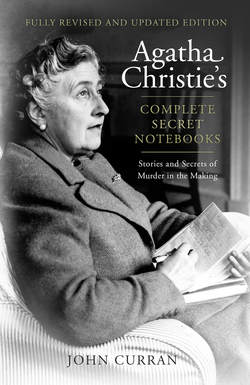Читать книгу Agatha Christie’s Complete Secret Notebooks - Агата Кристи, Agatha Christie, Detection Club The - Страница 12
The Beginning of a Career
ОглавлениеThat was the beginning of the whole thing. I suddenly saw my way clear. And I determined to commit not one murder, but murder on a grand scale.
And Then There Were None, Epilogue
SOLUTIONS REVEALED
Death on the Nile • Evil under the Sun • The Hollow • Lord Edgware Dies • The Murder at the Vicarage • The Mysterious Affair at Styles • Ordeal by Innocence • Witness for the Prosecution
The Golden Age of British detective fiction is generally regarded as the period between the end of the First World War and that of the Second, i.e. 1920 to 1945. This was the era of the country house weekend enlivened by the presence of a murderer, the evidence of the adenoidal under-housemaid, the snow-covered lawn with no footprints and the baffled policeman seeking the assistance of the gifted amateur. Ingenuity reached new heights with the fatal air embolism via the empty hypodermic, the poison-smeared postage stamp, and the icicle dagger that evaporates after use.
During these years all of the names we now associate with the classic whodunit began their writing careers. The period ushered in the fiendish brilliance of John Dickson Carr, who devised more ways to enter and leave a locked room than anyone before or since; it saluted the ingenuity of Freeman Wills Crofts, master of the unbreakable alibi, and Anthony Berkeley, pioneer of multiple solutions. It saw the birth of Lord Peter Wimsey, created by Dorothy L. Sayers, whose fiction and criticism did much to improve the literary level and acceptance of the genre; the emergence of Margery Allingham, who proved, with her creation Albert Campion, that a good detective story could also be a good novel; and the appearance of Ngaio Marsh, whose hero, Roderick Alleyn, managed to combine the professions of policeman and gentleman. Across the Atlantic it welcomed Ellery Queen and his penultimate chapter ‘Challenge to the Reader’, defying the armchair detective to solve the puzzle; S.S. Van Dine and his pompous creation Philo Vance breaking publishing records; and Rex Stout’s overweight creation Nero Wolfe, solving crimes while tending his orchid collection.
Cabinet ministers and archbishops extolled the virtues of a good detective story; poets (Nicholas Blake, otherwise Cecil Day Lewis), university dons (Michael Innes, otherwise Professor J.I.M. Stewart), priests (Rev. Ronald Knox), composers (Edmund Crispin, otherwise Bruce Montgomery) and judges (Cyril Hare, otherwise Judge Gordon Clark) contributed to and expanded the form. R. Austin Freeman and his scientific Dr John Thorndyke sowed the seeds of the modern forensic crime novel; Gladys Mitchell introduced a psychologist detective in her outrageous creation Mrs Bradley; and Henry Wade prepared the ground for the police procedural with his Inspector Poole. Books were presented in the form of correspondence in Sayers’ The Documents in the Case, as verbatim question-and-answer evidence in Philip Macdonald’s The Maze and, ultimately, as actual police dossiers complete with physical clues of telegrams and train tickets in Dennis Wheatley’s Murder off Miami. Floor plans, clue-finders, timetables and footnotes proliferated; readers became intimately acquainted with the properties of arsenic, the interpretation of train timetables and the intricacies of the 1926 Legitimacy Act. Collins Crime Club and the Detection Club were founded; Ronald Knox issued a Detective Story Decalogue and S.S. Van Dine wrote his Rules.
And Agatha Christie published The Mysterious Affair at Styles.
